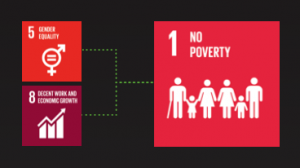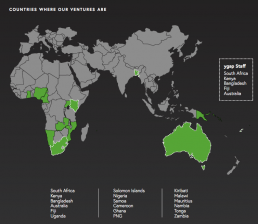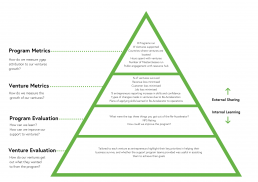Staying Aligned - ygap's approach to impact measurement
Impact measurement takes on many forms, shapes and sizes. This is how we approach ours.

Who we are
ygap is an international development organisation that supports early-stage social impact ventures with locally-led solutions to local problems. We believe in the power of entrepreneurship as an effective and sustainable way to provide opportunities for people to lift themselves out of poverty and disadvantage. We find, accelerate and support the growth of impact ventures led by local entrepreneurs who deeply understand the unique challenges of their communities and are best placed to develop solutions. We currently support ventures across Africa, South Asia, the Pacific Islands and Australia. ygap has offices and local teams that lead our programs in each area that we work.
ygap’s Monitoring, Evaluation & Learning (MEL) journey started from the very beginning.
Since the first cohort of ventures we supported back in 2013, we have sought to answer the question – How do we know that our program is achieving what we want it to – to empower local entrepreneurs in emerging markets to strengthen their early-stage businesses and set themselves up for the best chance to grow and succeed?
Over the years we have done surveys, engaged in conversations with our entrepreneurs and monitored specific indicators to help us build the case for our accelerator program model. We have sought to refine and adapt our support according to the needs of our entrepreneurs.
Three key elements of ygap’s approach to MEL
The first, is that we are SDG-aligned. By supporting early-stage impact ventures, we are directly contributing to Goal 1: No Poverty and Goal 8: Decent Work and Economic Growth. We also contribute to Goal 5: Gender Equality through empowering female-entrepreneurs in our yher programs and ensuring that our wider ygap program is accessible to all genders.

The second element is considering what is ygap-direct impact. These are the outputs of our program that we have direct control over. This is quantified through metrics such as how many programs we’ve run, how many ventures we’ve supported, and where these ventures are located. We also track a number of indicators which help give us an idea of the intermediate outcomes of the support we provide these ventures, including their survival rate up to two years post-program, as well as their growth in revenue, job creation, and beneficiary reach. Although there is no exact science to determine just how big a part our program played in these indicators, we record the operational aspects of our programmatic intervention such as the growth in knowledge and skills, the number of hours of 1:1 support provided, significant connections brokered, and funding distributed to support our claim for attribution.


The third aspect of our MEL approach is monitoring the effects that the ventures we support have on the communities they work with, up to two years post-program. We recognise that the ventures we work with are the ones who are doing the important work in inciting local change, whether it is by providing STEM education to young girls or training small-holder farmers to increase their crop yields. We track the SDGs that participating ventures align with, which all contribute to SDG 1: No poverty as we recognise that the causes of poverty are multi-faceted.
In collecting this data we ask ventures to measure, to the best of their ability, the number of people that have been impacted by their work. As all our ventures are working towards SDG 1: No Poverty, these beneficiaries comprise an overall estimation of the number of people who have an opportunity to lift themselves out of poverty through the 552 ventures working towards this goal.


Our ventures’ impact focus areas: See the number of ventures focused on a particular SDG under each icon. Each venture aligns with at least one SDG and all are contributing to the greater goal of SDG 1: No poverty
Guiding principles for Impact measurement
In developing an impact measurement framework in response to these three interlocked perspectives of understanding impact at ygap, we keep the following considerations in mind:
Simplicity – We recognise that we are a lean organisation, working with early-stage ventures who are also running lean. This often means the resources available for data collection and reporting are limited. Therefore, we want to make sure that the data we are asking of ourselves and of our ventures are the most pertinent metrics that will help us understand growth patterns and program effectiveness. Where possible, we want to be asking for the minimum amount of data in order to avoid reporting fatigue and creating extra burden on our portfolio ventures. This is especially relevant in times of crisis as ventures are already stretched.
Global trends – In order to aggregate an amount of data across all our programs to see some global patterns and overall trends of ygap at large, we need some level of uniformity in the MEL frameworks created across programs. For the resiliency programs we are running in light of COVID-19, the main indicators include the rate of venture survival during and after our support program and whether the impacts to revenue and staff are minimised or maintained.
Venture-specific success – Aside from tracking overall ygap trends, specific programs may identify and monitor custom metrics based on the needs they’re seeing in their ventures. A cohort of ventures may be at very different stages of their start-up journey, and we recognise that what success means for one venture could look very different to the next, and therefore what is successful support is also different. Always trying to improve, we are trialling this type of tailored, venture-specific MEL framework with our ygap South African Re-Accelerator Program, after our South African team identified the ventures they were working with had varying needs of support, with some needing to create better processes within their operations, and others requiring advice on how to access the right type of funding for their business pivot. We will be taking on more of a story-telling approach with our evaluation, drawing from monitoring techniques such as Most Significant Change.
External and internal communications – Lastly, we differentiate between what data we share with stakeholders and the wider public in order to showcase the work we do with our ventures, and what data is for our own internal use, to evaluate the effectiveness of our programs, identify changes we need to make, learn and ultimately improve as an organisation.
Putting these principles into practice, this is the organisational MEL Framework we’ve put in place to evaluate the effectiveness of our COVID-19 Resiliency Programs:

Our approach to MEL has come a long way and the journey will continue on for time to come. An effective MEL strategy is an evolving art that needs to be adapted with every program and involve stakeholders as much as possible. We are learning heaps along the way and look forward to sharing with you what insights we find through our Re-Accelerator Programs.
– Hedda Ngan, Monitoring, Evaluation & Learning (MEL) Officer, ygap

